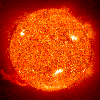 |
||
| First page | ||
 |
||
| Composition | ||
 |
||
| Activity | ||
 |
||
| The Sun as a star | ||
 |
||
| How/Why study? | ||
 |
Importance for us | |
 |
||
| Find out more | ||
 |
||
 |
||

The Sun seems to be a lot brighter than all the other stars and it is a lot more important to life on earth. Will the Sun always be there? Is our Sun the only of it's kind? We will try our best to answer those questions on this page.
Stars come in many different sizes, brightness and temperatures, and they can all be plotted in a so called Hertzsprung-Russell (H-R) diagram according to their features. On our tutorial about stars you will find more information about the H-R diagram, but for now it will be enough to know that it's a tool to see how a star's future is likely to be and what it's past has been like. Our Sun can be found almost in the middle of the main sequence, which is the name for a line where most of the stars we see at night are represented (about 90% of the stars surrounding our solar system). This observation is evidence that most stars have a composition similar to that of the Sun. If our Sun's not really that unique, what if there are other solar systems like ours too? It's an interesting thought.
The Sun emits huge amounts of radiation to be able to shine and that takes a lot of energy and the cost is a loss of mass and a different chemical profile. The Sun is however neither expanding (getting bigger) or contracting (shrinking) but stable so there's no need to worry yet for another thousands of billion years.
By studying the evolution of stars you realise just how special, and ordinary, the Sun really is. If you want to know more about stellar evolution in general, have a look at the MSSL guide to stellar evolution
Never look at the Sun directly. Doing so will destroy the retinas of your eyes.
10th September 2000
Sarah Amandusson
www_astro@mssl.ucl.ac.uk